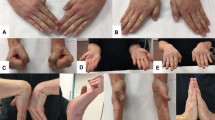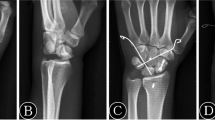Abstract
Background
The aims of this study were to evaluate the associated injuries occurring with acute perilunate instability and to assess the clinical and radiographic outcomes of perilunate dislocations and fracture–dislocations treated with a combined dorsal and volar approach.
Methods
A total of 45 patients (46 wrist injuries) with perilunate dislocations and fracture–dislocations were prospectively evaluated. The size of the mid-carpal ligament tear, the location of the scapholunate ligament tear, and the presence of osteochondral fragments and of the dorsal radiocarpal ligament avulsions were recorded at injury. Final clinical and radiographic outcomes were evaluated in 25 cases (25 wrists) with a minimum of 6 months of follow-up.
Results
Intraoperative examination of the 46 cases with operative treatment showed the volar carpal ligament tear to be present 100 % of the time and to be an average length of 3.4 cm. Complete avulsion of the dorsal extrinsic radiocarpal ligaments was found in 65.2 % of cases. The scapholunate ligament was torn in 35 cases. Osteochondral fragments were found either volarly or dorsally in 74 % of the cases. The average flexion–extension arc was 82°, forearm rotation was 155°, and grip strength averaged 59 % of the uninjured hand. The average final scapholunate angle was 55° and the scapholunate gap was 2.2 mm.
Conclusion
Treatment of perilunate fracture–dislocations with a combined volar and dorsal approach results in reasonable and functional clinical results. The incidence of associated injuries with these carpal dislocations is high. Although the perilunate fracture–dislocations have a slightly better radiologic alignment than the dislocation group, the clinical outcome is similar.



Similar content being viewed by others
References
Apergis E, Maris J, Theodoratos G, Pavlakis D, Antoniou N. Perilunate dislocations and fracture–dislocations. Closed and early open reduction compared in 28 cases. Acta Orthop Scand Suppl. 1997;275:55–9.
Blazar PE, Murray P. Treatment of perilunate dislocations by combined dorsal and palmar approaches. Tech Hand Up Extrem Surg. 2001;5:2–7.
Boorman RS, Shrive NG, Frank CB. Immobilization increases the vulnerability of rabbit medial collateral ligament autografts to creep. J Orthop Res. 1998;16:682–9.
Campbell Jr RD, Thompson TC, Lance EM, Adler JB. Indications for open reduction of lunate and perilunate dislocations of the carpal bones. J Bone Joint Surg Am. 1965;47:915–37.
Cooney WP, Bussey R, Dobyns JH, Linscheid RL. Difficult wrist fractures. Perilunate fracture–dislocations of the wrist. Clin Orthop Relat Res. 1987;214:136–47.
DiGiovanni B, Shaffer J. Treatment of perilunate and transscaphoid perilunate dislocations of the wrist. Am J Orthop (Belle Mead NJ). 1995;24:818–26.
Forli A, Courvoisier A, Wimsey S, Corcella D, Moutet F. Perilunate dislocations and transscaphoid perilunate fracture–dislocations: a retrospective study with minimum ten-year follow-up. J Hand Surg Am. 2010;35:62–8.
Green DP, O’Brien ET. Open reduction of carpal dislocations: indications and operative techniques. J Hand Surg Am. 1978;3:250–65.
Herbert TJ, Fisher WE. Management of the fractured scaphoid using a new bone screw. J Bone Joint Surg Br. 1984;66:114–23.
Herzberg G, Comtet JJ, Linscheid RL, Amadio PC, Cooney WP, Stalder J. Perilunate dislocations and fracture–dislocations: a multicenter study. J Hand Surg Am. 1993;18:768–79.
Herzberg G, Forissier D. Acute dorsal trans-scaphoid perilunate fracture–dislocations: medium-term results. J Hand Surg Br. 2002;27:498–502.
Hildebrand KA, Ross DC, Patterson SD, Roth JH, MacDermid JC, King GJ. Dorsal perilunate dislocations and fracture–dislocations: questionnaire, clinical, and radiographic evaluation. J Hand Surg Am. 2000;25:1069–79.
Inoue G, Imaeda T. Management of trans-scaphoid perilunate dislocations. Herbert screw fixation, ligamentous repair and early wrist mobilization. Arch Orthop Trauma Surg. 1997;116:338–40.
Inoue G, Kuwahata Y. Management of acute perilunate dislocations without fracture of the scaphoid. J Hand Surg Br. 1997;22:647–52.
Knirk JL, Jupiter JB. Intra-articular fractures of the distal end of the radius in young adults. J Bone Joint Surg Am. 1986;68:647–59.
Knoll VD, Allan C, Trumble TE. Trans-scaphoid perilunate fracture dislocations: results of screw fixation of the scaphoid and lunotriquetral repair with a dorsal approach. J Hand Surg Am. 2005;30:1145–52.
Komurcu M, Kurklu M, Ozturan KE, Mahirogullari M, Basbozkurt M. Early and delayed treatment of dorsal transscaphoid perilunate fracture–dislocations. J Orthop Trauma. 2008;22:535–40.
Lichtman DM, Mack GR, MacDonlad RI, Gunther SF, Wilson JN. Kienböck’s disease: the role of silicone replacement arthroplasty. J Bone Joint Surg Am. 1977;7:899–908.
Lutz M, Arora R, Kammerlander C, Gabl M, Pechlaner S. Stabilization of perilunate and transscaphoid perilunate fracture–dislocations via a combined palmar and dorsal approach. Oper Orthop Traumatol. 2009;21:442–58.
Mayfield JK, Johnson RP, Kilcoyne RK. Carpal dislocations: pathomechanics and progressive perilunar instability. J Hand Surg Am. 1980;5:226–41.
Nattrass GR, King GJ, McMurtry RY, Brant RF. An alternative method for determination of the carpal height ratio. J Bone Joint Surg Am. 1994;76:88–94.
Raab DJ, Fischer DA, Quick DC. Lunate and perilunate dislocations in professional football players. A five-year retrospective analysis. Am J Sports Med. 1994;22:841–5.
Schaller P, Grunert J. Late outcome after surgical treatment of perilunar dislocation and dislocation fractures. Handchir Mikrochir Plast Chir. 1998;30:298–302.
Sotereanos DG, Mitsionis GJ, Giannakopoulos PN, Tomaino MM, Herndon JH. Perilunate dislocation and fracture dislocation: a critical analysis of the volar–dorsal approach. J Hand Surg Am. 1997;22:49–56.
Su CJ, Chang MC, Liu Y, Lo WH. Lunate and perilunate dislocation. Zhonghua Yi Xue Za Zhi (Taipei). 1996;58:348–54.
Trumble T, Verheyden J. Treatment of isolated perilunate and lunate dislocations with combined dorsal and volar approach and intraosseous cerclage wire. J Hand Surg Am. 2004;29:412–7.
Witvoet J, Allieu Y. Recent traumatic lesions of the semilunar bone. Rev Chir Orthop Reparatrice Appar Mot. 1973;59 Suppl 1:98–125.
Conflict of Interest
The authors declare that they have no conflicts of interest, commercial associations, or intent of financial gain regarding this research.
Author information
Authors and Affiliations
Corresponding author
Additional information
Type of the study and the level of evidence: Prospective, Level II
About this article
Cite this article
Capo, J.T., Corti, S.J., Shamian, B. et al. Treatment of dorsal perilunate dislocations and fracture–dislocations using a standardized protocol. HAND 7, 380–387 (2012). https://doi.org/10.1007/s11552-012-9452-y
Published:
Issue Date:
DOI: https://doi.org/10.1007/s11552-012-9452-y




